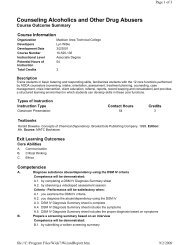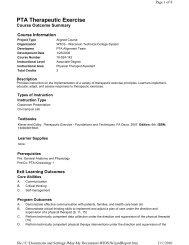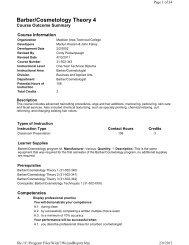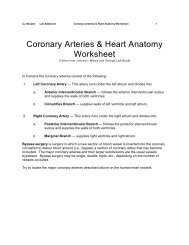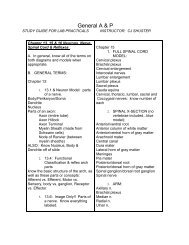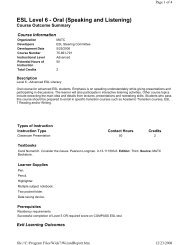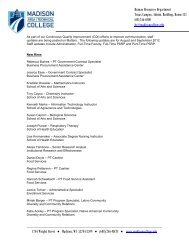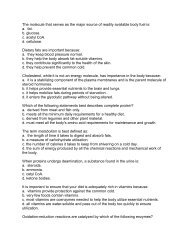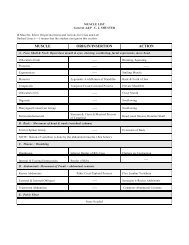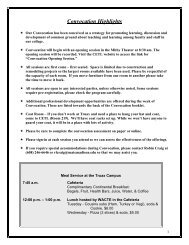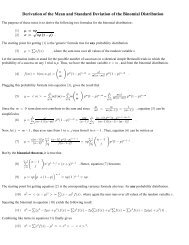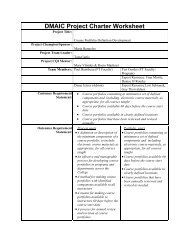Physics of Everyday Life - Madison Area Technical College
Physics of Everyday Life - Madison Area Technical College
Physics of Everyday Life - Madison Area Technical College
Create successful ePaper yourself
Turn your PDF publications into a flip-book with our unique Google optimized e-Paper software.
file://C:\Program Files\Wids7\WizardReport.htm<br />
Page 1 <strong>of</strong> 3<br />
6/20/2011<br />
<strong>Physics</strong> <strong>of</strong> <strong>Everyday</strong> <strong>Life</strong><br />
Course Outcome Summary<br />
Course Information<br />
Organization<br />
<strong>Madison</strong> <strong>Area</strong> <strong>Technical</strong> <strong>College</strong><br />
Developers<br />
William Caplan<br />
Development Date 6/15/2011<br />
Course Number 20806220<br />
Instructional Level <strong>College</strong> Transfer<br />
Total Credits 3<br />
Description<br />
Have you ever looked at something and said to yourself "I wonder how that works?" If so, this is the course for<br />
you. The <strong>Physics</strong> <strong>of</strong> <strong>Everyday</strong> <strong>Life</strong> will explore basic principles <strong>of</strong> physics including classical mechanics, fluids,<br />
heat, resonance, waves, light and electricity and magnetism through the lens <strong>of</strong> everyday objects. We will gain<br />
insight through studying objects such as bumper cars, roller coasters, light bulbs, musical instruments and<br />
microwave ovens.<br />
Target Population<br />
For non science major college transfer<br />
Types <strong>of</strong> Instruction<br />
Instruction Type Contact Hours Credits<br />
Face to face 3<br />
Textbooks<br />
Louis A. Bloomfield. How Things Work: The <strong>Physics</strong> <strong>of</strong> <strong>Everyday</strong> <strong>Life</strong>. Wiley. January 9, 2009. Edition: 4th<br />
edition. Pages: 632. ISBN: 978-0470223994 .<br />
Learner Supplies<br />
Caculator.<br />
Prerequisites<br />
Basic Algebra, 74854793 or Elem Algebra w/Apps , 10804110 or Elem Algebra w/Apps10834110 or Algebra<br />
Concepts 10804140 with a grade <strong>of</strong> C or score <strong>of</strong> 40+ on the algebra component <strong>of</strong> COMPASS.<br />
Competencies<br />
1. Explore basics principles <strong>of</strong> physics from fields such as classical mechanics, thermal<br />
physics, fluid statics and dynamics, oscillation, resonance and waves, electricity and<br />
magnetism, light, and modern physics<br />
You will demonstrate your competence by:<br />
o completing homework assignments<br />
o completing a written exam<br />
o participating in guided small group discussions<br />
o answering iClicker questions in class<br />
Your performance will be successful when you:<br />
o describe the basic principles in everyday English
file://C:\Program Files\Wids7\WizardReport.htm<br />
Page 2 <strong>of</strong> 3<br />
6/20/2011<br />
o use a vocabulary <strong>of</strong> physics terms and concepts in answering questions in classroom discussion<br />
and written assignments<br />
o distinguish between everyday English language usage and scientific usage <strong>of</strong> terms. Example:<br />
The word work has several meanings in English: getting something done, drudgery, employment,<br />
etc. In physics it refers to energy transfer involving forces and motion.<br />
o identify relationships between physics concepts. Example: Kinetic energy is energy <strong>of</strong> motion. It<br />
depends on how fast something moves and how massive it is<br />
o identify the units associated with physics concepts<br />
o give an example <strong>of</strong> an everyday object or process which uses the physics concept<br />
2. Apply physics concepts to everyday situations to solve problems<br />
You will demonstrate your competence by:<br />
o completing homework assignments<br />
o completing a written exam<br />
o participating in classroom discussion<br />
o answering iClicker questions in class<br />
o writing a journal regarding applications <strong>of</strong> course material<br />
o contributing to a wiki applying course material<br />
Your performance will be successful when you:<br />
o analyze everyday problems and identify the physics principles present<br />
o explain the application <strong>of</strong> physics principles to a problem. Example: I'm trying to change a flat tire<br />
and one <strong>of</strong> the bolts is stuck. I need to increase the amount <strong>of</strong> torque provided to the bolt<br />
o explain the parameters involved with the problem, and how they can be adjusted to solve the<br />
problem. Example: Torque depends on force and distance from the center <strong>of</strong> rotation. In order to<br />
increase the torque I could push harder on the wrench. If I can t push hard enough, I could put I pipe<br />
over the end <strong>of</strong> the wrench, making the wrench longer, and push on the end <strong>of</strong> the pipe.<br />
o estimate relevant physical quantities in the problem<br />
o perform simple, rough calculations to solve problems<br />
3. Identify how common devices and processes work using applicable physics principles<br />
You will demonstrate your competence by:<br />
o completing homework assignments<br />
o completing a written exam<br />
o participating in classroom discussion<br />
o answering iClicker questions in class<br />
o writing a journal regarding applications <strong>of</strong> course material<br />
o contributing to a wiki applying course material<br />
Your performance will be successful when you:<br />
o analyze everyday devices and processes and identifies the physics principles present<br />
o explain how physics principles make the object or process work<br />
o explain the parameters involved with the object or process and how adjusting them affects<br />
performance. Example: A 100 watt incandescent light bulb purchased in <strong>Madison</strong> is designed to<br />
operate on U.S. standard 120 V electricity. If the same light bulb is used in Europe where electricity<br />
is provided at 220 V, it will either glow brighter (putting out more than 100 W) or blow out.<br />
o discuss thoroughly the objects presented in the text and lectures in terms <strong>of</strong> the relevant physics<br />
in exams, written assignments and classroom discussion<br />
4. Use appropriate physics formulae to solve simple physics problems<br />
You will demonstrate your competence by:<br />
o completing homework assignments<br />
o completing a written exam<br />
o participating in classroom discussion<br />
o answering iClicker questions in class
file://C:\Program Files\Wids7\WizardReport.htm<br />
Page 3 <strong>of</strong> 3<br />
6/20/2011<br />
Your performance will be successful when you:<br />
o identify relevant formulae related to the applicable physics principle<br />
o identify conditions or parameters given in a problem and relate them to terms in the formula<br />
o substitute given values into a formula and solve for the unknown<br />
o identify and use appropriate units in your solution<br />
5. Discuss the relationship between physics formulae and application to real world processes.<br />
You will demonstrate your competence by:<br />
o participating in classroom discussion<br />
o completing a written exam<br />
o answering iClicker questions in class<br />
o answering comparative or ranking questions<br />
Your performance will be successful when you:<br />
o describe in words the meaning <strong>of</strong> a physics formula. Example Newton s 2nd law ( a= F/m) means<br />
big forces create large accelerations, but that big masses are difficult to accelerate<br />
o approximate a formula based on an understanding <strong>of</strong> a process. Example: The rate <strong>of</strong> heat<br />
transfer through a wall <strong>of</strong> a house via conduction gets smaller as you make the wall thicker.<br />
Therefore rate=something/thickness<br />
o apply the formula qualitatively to explain how changing a parameter affects an outcome. Example:<br />
My car engine only puts out so much force. Therefore, if I fill my trunk with a load <strong>of</strong> bricks<br />
(increasing the mass) the acceleration will get worse



